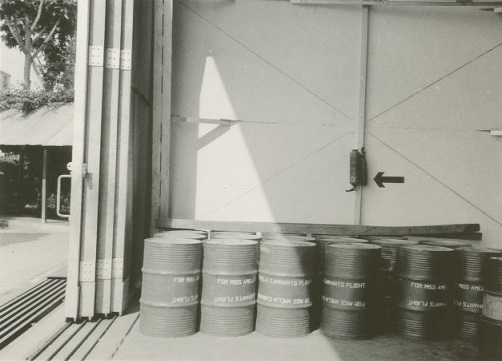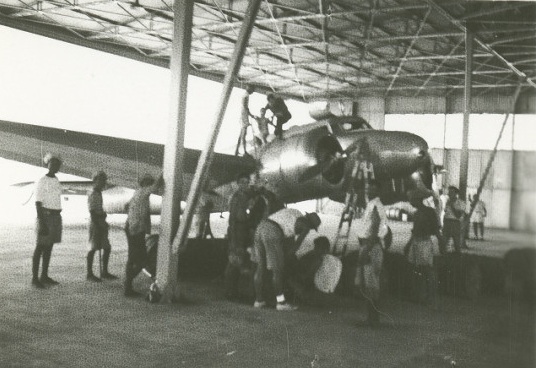

The SA 315B Lama was designed to perform at the very high altitudes and temperatures necessary for service with the Indian Army. It combined an SE.3130 Alouette II airframe with a much more powerful Turboméca Astazou IIIB turboshaft engine—derated to 550 shaft horsepower—and the rotor system, transmission and gearboxes from the larger 7-place Alouette III.

The record-setting helicopter was modified by removing all equipment that was not needed for the record flight attempt. Various instruments and the co-pilot and passengers seats were taken out of the cockpit, as well as the helicopter’s synchronized horizontal stabilizer and tail rotor guard. The standard fuel tank was replaced with a very small tank holding just 70 kilograms (approximately 22.7 gallons) of jet fuel. Turboméca modified the engine to increase the output shaft r.p.m. by 6%. After Jean Boulet started the turbine engine, mechanics removed the battery and starter motor to decrease the weight even further.

In just 12 minutes, the Lama had climbed to 11,000 meters (36,089 feet). As he approached the peak altitude, the forward indicated airspeed had to be reduced to 30 knots (34.5 miles per hour, 55.6 kilometers per hour) to prevent the advancing main rotor blade tip from reaching its Critical Mach Number in the thin air, which would have resulted in the blade stalling. At the same time, the helicopter was approaching Retreating Blade Stall.
When the helicopter could climb no higher, Boulet reduced power and decreased collective pitch. The Turboméca engine, not calibrated for the very high altitude and cold temperature, -62 °C. (-80 °F.), flamed out. With no battery and starter, a re-start was impossible. Boulet put the Lama into autorotation for his nearly eight mile descent. Entering multiple cloud layers, the Plexiglas bubble iced over. Because of the ice and clouds, the test pilot had no outside visibility. Attitude instruments had been removed to lighten the helicopter. Boulet looked up through the canopy at the light spot in the clouds created by the sun, and used that for his only visual reference until he broke out of the clouds.
Still in autorotation, the SA 315 missed touching down exactly on its takeoff point, but was close enough that FAI requirements were met.

Two days earlier, 19 June 1972, Boulet and fellow test pilot Gérard Boutin had set another FAI World Record for Altitude Without Payload, when they flew the Lama to 10,856 meters (35,617 feet).³ This record also still stands.


The fuselage is 10.26 meters (33 feet, 7.9 inches) long. With all rotors turning, the helicopter has an overall length of 12.92 meters (42 feet, 4.7 inches) and height of 3.09 meters (10 feet, 1.7 inches). The SA 315B has an empty weight of 1,021 kilograms (2,251 pounds) and a maximum gross weight of 1,950 kilograms (4,299 pounds). With an external load carried on its cargo hook, the maximum gross weight is 5,070 pounds (2,300 kilograms).
The three-bladed, fully-articulated main rotor has a diameter of 11.02 meters (36 feet, 1.9 inches). It turns clockwise, as seen from above. (The advancing blade is on the left side of the helicopter.) Normal main rotor speed, NR, is 350–360 r.p.m. The three-bladed anti-torque tail rotor is 1.91 meters (6 feet, 3.2 inches) in diameter and turns clockwise, as seen from the helicopter’s left side. (The advancing blade is below the axis of rotation.) It turns at 2,020 r.p.m.

The helicopter has a cruise speed 103 knots (191 kilometers per hour, 119 miles per hour) and a maximum speed of 113 knots (209 kilometers per hour, 130 miles per hour) at Sea Level. The service ceiling is 5,400 meters (17,717 feet). At 1,950 kilograms (4,299 pounds), the Lama has a hover ceiling in ground effect (HIGE) of 5,050 meters (16,568 feet), and out of ground effect (HOGE), 4,600 meters (15,092 feet).
Société nationale des constructions aéronautiques du Sud-Est became Aérospatiale in 1970. The company produced the SA 315B Lama beginning in 1971. It was also built under license by Hundustan Aeronautics in India and Helibras in Brazil.
The total number of SA 315Bs and its variants built is uncertain. In 2010, Eurocopter, the successor to Aérospatiale, announced that it will withdraw the Lama’s Type Certificate in 2020.

After setting the world altitude record, 315-001 was returned to the standard configuration and assigned registration F-BPXS. It crashed at Flaine, a ski resort in the French Alps, 23 February 1985.


Jean Ernest Boulet was born 16 November 1920, in Brunoy, southeast of Paris, France. He was the son of Charles-Aimé Boulet, an electrical engineer, and Marie-Renée Berruel Boulet.
He graduated from Ecole Polytechnique in 1940 and the Ecole Nationale Supérieure de l’aéronautique In 1942. (One of his classmates was André Edouard Turcat, who would also become one of France’s greatest test pilots.)
Following his graduation, Boulet joined the Armée de l’Air (French Air Force)and was commissioned a sous-lieutenant. He took his first flight lesson in October. After the surrender of France to the Nazi invaders, Boulet’s military career slowed. He applied to l’Ecole Nationale Supérieure de l’Aéronautique in Toulouse for post-graduate aeronautical engineering. He completed a master’s degree in 1943.
During this time, Boulet joined two brothers with La Resistance savoyarde, fighting against the German invaders as well as French collaborators.
In 1943, Jean Boulet married Mlle. Josette Rouquet. They had two sons, Jean-Pierre and Olivier.
In February 1945, Sous-lieutenant Boulet was sent to the United States for training as a pilot. After basic and advanced flight training, Bouelt began training as a fighter pilot, completing the course in a Republic P-47D Thunderbolt. He was then sent back to France along with the other successful students.
On 1 February 1947 Jean Boulet joined Société nationale des constructions aéronautiques du Sud-Est (SNCASE) as an engineer and test pilot. He returned to the United States to transition to helicopters. Initially, Boulet and another SNCASE pilot were sent to Helicopter Air Transport at Camden Central Airport, Camden, New Jersey, for transition training in the Sikorsky S-51. An over-enthusiastic instructor attempted to demonstrate the Sikorsky to Boulet, but lost control and crashed. Fortunately, neither pilot was injured. Boulet decided to go to Bell Aircraft at Niagara Falls, New York, where he trained on the Bell Model 47. He was awarded a helicopter pilot certificate by the U.S. Federal Aviation Administration, 23 February 1948.


As a test pilot Boulet made the first flight in every helicopter produced by SNCASE, which would become Sud-Aviation and later, Aérospatiale (then, Eurocopter, and now, Airbus Helicopters).
While flying a SE 530 Mistral fighter, 23 January 1953, Boulet entered an unrecoverable spin and became the first French pilot to escape from an aircraft by ejection seat during an actual emergency. He was awarded the Médaille de l’Aéronautique.
Jean Boulet was appointed Chevalier de la légion d’honneur in 1956, and in 1973, promoted to Officier de la Légion d’honneur.
Jean Boulet had more than 9,000 flight hours, with over 8,000 hours in helicopters. He set 24 Fédération Aéronautique Internationale world records for speed, distance and altitude. Four of these are current.
Jean Boulet wrote L’Histoire de l’Helicoptere: Racontée par ses Pionniers 1907–1956, published in 1982 by Éditions France-Empire, 13, Rue Le Sueuer, 75116 Paris.
Jean Ernest Boulet died at Aix-en-Provence, in southern France, 15 February 2011, at the age of 90 years.

¹ FAI Record File Number 11657: Class: E (Rotorcraft): Sub-Class: E-Absolute (Absolute Record of class E)
² FAI Record File Number 753: Altitude Without Payload: Sub-Class: E-1b (Helicopters: take off weight 500 to 1000 kg). FAI Record File Number 754: Altitude Without Payload: Sub-Class: E-1 (Helicopters).
³ FAI Record File Number 788: Altitude Without Payload: Sub-Class E-1c.
© 2018, Bryan R. Swopes























